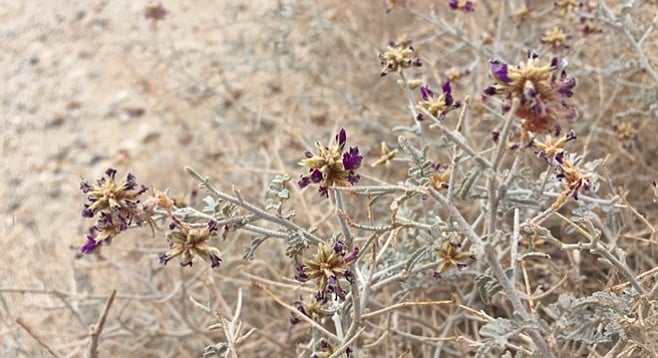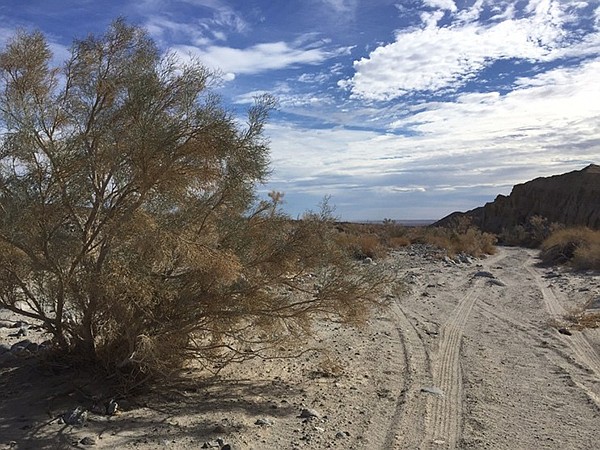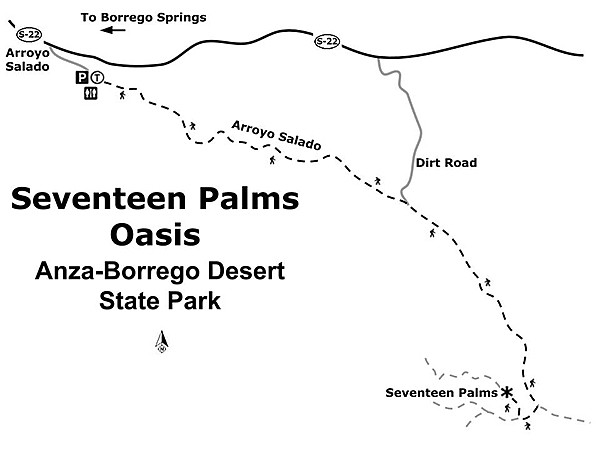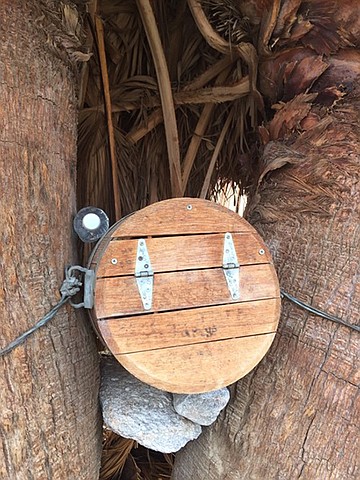 Facebook
Facebook
 X
X
 Instagram
Instagram
 TikTok
TikTok
 Youtube
Youtube

Seventeen Palms Oasis is one of the popular places to visit in Anza-Borrego Desert State Park. It has been a desert watering stop for over 100 years. A good way to experience early desert travel is to walk to the oasis from the primitive camping area near the highway. This allows visitors to view desert plants and surroundings up close.
Follow the jeep road that passes the toilets (facing them to your left) for 3.5 miles. If you don’t have a dog along, you may leave the road and walk on the harder surfaces of the wash. This is a desert state wilderness area, protected by the government to maintain its natural condition. Littering is illegal—pack out all of your trash.
Early on, look for the piles and hills of mud composed of rocks, concretions, crumbly mud, and limestone deposits. Observe how the roots of the thirsty plants dig deep into the earth in search of water. Visualize paths of water where it has flowed during floods.

A native bush frequently found in washes, looking like columns of gray smoke and growing up to 20 feet tall, is the smoke tree (Psorothamnus spinosus), which is a member of the pea family. It has stiff, gray, spiny branches. After rains, it sprouts small leaves. It usually bloomsin late spring to early summer, with small, dark purple flowers. You may see blooms earlier. For photosynthesis, it has a layer of chlorophyll under the gray hairy surface on its branches.
As you walk, you might spot another native bush that has the appearance of a Renoir painting—a fuzzy light blue-green appearance. Approaching it, you will see clusters of purple flowers (Nov-May). Rub your fingers over them and smell the wonderful aroma of lavender! This is the desert lavender bush. Look for the hummingbirds, butterflies, and bees that it attracts. Occasionally, a bird’s nest can be spotted, as they are often at eye level.

After 3 miles, you will see a fork in the road and an arrow sign pointing to the right. Take the right fork. You will see a palm grove in the near distance. No dogs or pets are allowed at the oasis. This oasis has been known as Seventeen Palms since at least 1889, and since that time, some palms have died and other palms have grown. No doubt it had 17 palms when first named. The oasis has changed over the years, and today, there are two separate groupings totaling over 30 palms. The palms are native California fan palms (Washingtonia filifera). They require a consistent water source, such as a stream, a seep, or a water source just below the surface. They are often located over fault lines where ground water can come up through the fractures. The roots are shallow and can easily access this water. Thirsty coyote are known to dig for water at the base of a palm tree if there is no surface water. Notice the skirts of old palm fronds. Birds, mice, and other critters make their homes in this thick shelter, and many kinds of wildlife seek out the life-giving water here in the oasis. Over 100 species of birds are known to stop and refresh themselves at this spot.
Surrounding the area, you will notice that the ground is moist, with a white crust. These are the mineral salts that are left behind when the water evaporates from the alkaline soil. Note the crystals of salt coating the spiky salt grass seen here.
Another interesting bush here is white dalea or dyebush (Psorothamnus emoryi). It is also in the pea family, with clusters of small purple flowers with orange dye glands at the base. Rub these, and your fingers will have an orange stain on them!

The second small grove of trees has a post office barrel wedged between the trunks. Inside are visitors’ logs, connecting hikers across the years. Early travelers learned to look out for each other in the harsh desert conditions, so they wrote helpful notes and stashed water bottles for someone coming along afterwards—an early kind of “pay it forward.” Today, the water bottles tucked beside the barrel carry on the tradition of leaving extra water and notes for travelers.
Return by retracing your steps to the campground.
Directions: (Borrego Springs) From Christmas Circle in Borrego Springs, head east on Palm Canyon Drive/S-22 for 15.8 miles to the turnoff for Arroyo Salado Primitive Camp. About half a mile before the turnoff is mile marker 34, which will alert you to look for the small sign on the right for the Arroyo Salado camping area. It’s easy to miss. Turn on to the road, which is suitable for regular cars. In about 0.5 mile, the road forks. Stay to the left, and park in the open area near the toilets.
Hiking length: 7.1 miles round trip. Allow 4-5 hours hiking time. Carry plenty of water and snacks.
Difficulty: Easy, with no significant elevation gain/loss. Vault toilets in Arroyo Salado Primitive Campground (no fee, no water, remove own trash, and fires only in metal containers). Dogs on leashes and bicycles allowed on the road only; no pets allowed at the oasis.


Seventeen Palms Oasis is one of the popular places to visit in Anza-Borrego Desert State Park. It has been a desert watering stop for over 100 years. A good way to experience early desert travel is to walk to the oasis from the primitive camping area near the highway. This allows visitors to view desert plants and surroundings up close.
Follow the jeep road that passes the toilets (facing them to your left) for 3.5 miles. If you don’t have a dog along, you may leave the road and walk on the harder surfaces of the wash. This is a desert state wilderness area, protected by the government to maintain its natural condition. Littering is illegal—pack out all of your trash.
Early on, look for the piles and hills of mud composed of rocks, concretions, crumbly mud, and limestone deposits. Observe how the roots of the thirsty plants dig deep into the earth in search of water. Visualize paths of water where it has flowed during floods.

A native bush frequently found in washes, looking like columns of gray smoke and growing up to 20 feet tall, is the smoke tree (Psorothamnus spinosus), which is a member of the pea family. It has stiff, gray, spiny branches. After rains, it sprouts small leaves. It usually bloomsin late spring to early summer, with small, dark purple flowers. You may see blooms earlier. For photosynthesis, it has a layer of chlorophyll under the gray hairy surface on its branches.
As you walk, you might spot another native bush that has the appearance of a Renoir painting—a fuzzy light blue-green appearance. Approaching it, you will see clusters of purple flowers (Nov-May). Rub your fingers over them and smell the wonderful aroma of lavender! This is the desert lavender bush. Look for the hummingbirds, butterflies, and bees that it attracts. Occasionally, a bird’s nest can be spotted, as they are often at eye level.

After 3 miles, you will see a fork in the road and an arrow sign pointing to the right. Take the right fork. You will see a palm grove in the near distance. No dogs or pets are allowed at the oasis. This oasis has been known as Seventeen Palms since at least 1889, and since that time, some palms have died and other palms have grown. No doubt it had 17 palms when first named. The oasis has changed over the years, and today, there are two separate groupings totaling over 30 palms. The palms are native California fan palms (Washingtonia filifera). They require a consistent water source, such as a stream, a seep, or a water source just below the surface. They are often located over fault lines where ground water can come up through the fractures. The roots are shallow and can easily access this water. Thirsty coyote are known to dig for water at the base of a palm tree if there is no surface water. Notice the skirts of old palm fronds. Birds, mice, and other critters make their homes in this thick shelter, and many kinds of wildlife seek out the life-giving water here in the oasis. Over 100 species of birds are known to stop and refresh themselves at this spot.
Surrounding the area, you will notice that the ground is moist, with a white crust. These are the mineral salts that are left behind when the water evaporates from the alkaline soil. Note the crystals of salt coating the spiky salt grass seen here.
Another interesting bush here is white dalea or dyebush (Psorothamnus emoryi). It is also in the pea family, with clusters of small purple flowers with orange dye glands at the base. Rub these, and your fingers will have an orange stain on them!

The second small grove of trees has a post office barrel wedged between the trunks. Inside are visitors’ logs, connecting hikers across the years. Early travelers learned to look out for each other in the harsh desert conditions, so they wrote helpful notes and stashed water bottles for someone coming along afterwards—an early kind of “pay it forward.” Today, the water bottles tucked beside the barrel carry on the tradition of leaving extra water and notes for travelers.
Return by retracing your steps to the campground.
Directions: (Borrego Springs) From Christmas Circle in Borrego Springs, head east on Palm Canyon Drive/S-22 for 15.8 miles to the turnoff for Arroyo Salado Primitive Camp. About half a mile before the turnoff is mile marker 34, which will alert you to look for the small sign on the right for the Arroyo Salado camping area. It’s easy to miss. Turn on to the road, which is suitable for regular cars. In about 0.5 mile, the road forks. Stay to the left, and park in the open area near the toilets.
Hiking length: 7.1 miles round trip. Allow 4-5 hours hiking time. Carry plenty of water and snacks.
Difficulty: Easy, with no significant elevation gain/loss. Vault toilets in Arroyo Salado Primitive Campground (no fee, no water, remove own trash, and fires only in metal containers). Dogs on leashes and bicycles allowed on the road only; no pets allowed at the oasis.
Comments